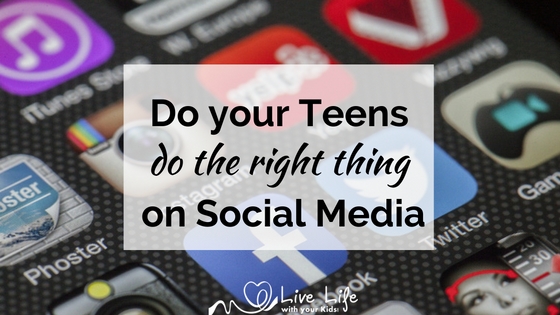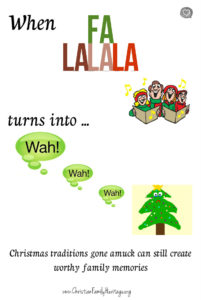Do Your Teens Do the Right Thing On Social Media?
I’m a big advocate for letting our teens be on social media. I think it is here to stay, and if our kids don’t learn how to do it well while they are in our home, and under our guidance, then when they get into the big wide world on their own, they will try it for sure, and undoubtedly make mistakes as they learn.
But I have some concerns about the words we use to teach them to use it well.
I recently read an article on “Burn Notes”; apparently, technology has made a way for things to disappear off the internet. We can go incognito on our browsers so our history isn’t recorded, and we can use social media apps where what we say is deleted once it is read by the intended recipient.
What struck me when I read this article is that teens are thinking that because of this technology what they have to say has no consequence – no-one will know. It seems as if teens are saying because there is no consequence I can say what I want – I can show what I want – and it will be okay.
This rings alarm bells for me as a parent – have I taught my kids to consider the consequences as the benchmark for right behaviour? (I hope not)
The consequence of Wet Cement
One of the restraints that parents use to teach their kids about online behaviour is the idea of wet cement – the idea that your actions are like footprints in wet cement – you cannot erase them.
Though this has some merit – and on some social media this is still the case – it doesn’t get to the heart of the matter. Talking about wet cement, which is simply telling our kids to be guided by negative consequences – has a shock factor, it raises concern and potentially caution but technology is taking us further away from the place where this issue is convincing. If technology advances to the point where comments are truly deleted – if the wet cement factor is taken away – how do parents teach their kids to be safe, respectful and responsible?
Social Media is just a big Party
Social Media is social – and though parents may struggle to see how it is real socialising, to our teens it is very much a way of connecting and relating to their friends, old and new.
I see social media like a big party, a very big party – and we go to parties where we don’t know everyone, and we make new friends at a party. This concept of social media being a big party can help us adjust our understanding of how the world is changing with social media and how our kids are taking it and running with it.
Because it is social, we need to teach our kids to act social – appropriately.
Sending our kids out the door to a party and reminding them to do the right thing by remembering that actions have consequences is a valid parenting conversation. I believe though that it falls short – there is a subtle message that we are saying if there are no consequences, you can do stupid things. Of course parents don’t mean this, but I wonder what teens hear?
The key message we should be telling our teens is: Wherever you are you are to be respectful and responsible. Wherever you are, you are to act in keeping with your values.
Teaching our kids these two principles will guide them regardless of the social contexts they find themselves in, regardless of the peer pressure to behave a certain way, regardless of the trends and fads of their generation.
Respect is always the Standard
The standard for all social situations is to respect yourself and love others. The issue of respect does not change for this new social setting of online social media.
When our kids use respect and love as the standard (as opposed to fear of consequences) it enables them to be social appropriately regardless of the situation. Their behaviour online becomes an issue of doing the right thing – out of a desire to do the right thing.
Teaching our kids to respect themselves
Respect is about knowing something is precious, has worth. We respect other people because they are special, unique, made by God, loved, they are valuable. And we are too. We have to be able to teach our kids that while they need to respect others they also need to respect themselves. They are just as valuable to God and others as the next person.
Our children need to know that they are precious in the sight of God. That God made them, loved them, bought them with his son’s blood, has a purpose for them and wants a relationship with them. When we see ourselves this way it shapes the things that we do or let be done to our self.
Teaching our kids to love others
For some reason social media tends to make people think just about themselves – but no social situation is ever just about one person. There are also at least one other to be social. We need to teach our teens, that when they go online, they need to consider the other person – just as if they were in the room face to face.
Respecting ourselves and loving others is the foundation for any healthy relationship. As we teach our teens to deal with the variety of social media interactions we need to make sure that it is these two things that come to their mind – it needs to be these two standards that direct their actions.
Social Media isn’t the bad Guy
Social media is just one place where our kids go to interact with people. They may also catch up with friends at school, sport events, activity clubs, work, church – in each of these contexts our teens will be creating social habits. I think it wise of parents to not make social media a different issue than any other social situation your kids face. Social is social – and at the heart of all social interaction is a relationship.
Part of the false thinking that teens get caught up in is the idea that I can say what I want because no-one will know (Burn Notes, or Snap Chat etc) but that isn’t true. The person who read the comment, they know. And if it was a message taking advantage of the short-lived nature of the technology – then it probably hurt, it was probably suspicious and probably wouldn’t have been said in a room full of other people.
It reminds me of the snide or niggly comments that siblings often make to each other – just under their breath – enough for the other sibling to hear, but not clear enough for mum and dad to hear. They know it is mean – it was intended to be mean – and yet delivered in such a way that they hope they fly under the radar and avoid detection by the parents.
Once again – it is a heart issue. What is in the heart of a sibling when they would do such a thing? What is in the heart of a teen when they do something similar online? In both situations the heart attitude is mean or rude – there is a lack of valuing the other person.
So social media isn’t the bad guy – our kids hearts are. Being social is a heart issue – therefore we need to give a heart reason for appropriate behaviour. Don’t teach your kids to act based on consequences – get them to consider the preciousness of the other person, and their own personal value system.
Belinda Letchford is a Contact Mom in Australia.



